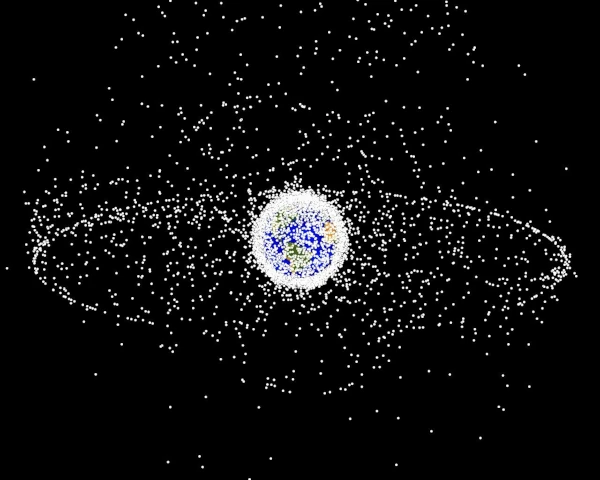
Space debris originates from defunct satellites, abandoned rocket stages, fragments from collisions, or explosions in orbit. More than 36,000 objects larger than 10 cm are currently being tracked. Their relative speed, which can reach \(v \approx 7.8 \, km/s\), gives these debris formidable kinetic energy during impacts.
| Event | Year | Altitude | Consequences |
|---|---|---|---|
| Explosion of the Fengyun-1C satellite (Chinese anti-satellite test) | 2007 | 865 km | Creation of over 3,000 tracked debris, still in orbit |
| Collision between Cosmos-2251 (Russia) and Iridium-33 (USA) | 2009 | 790 km | First major collision between two active satellites, generating >2,000 fragments |
| Explosion of an Ariane 1 rocket stage (V16 mission) | 1986 | ~600 km | Several hundred persistent debris, some still in orbit today |
| Indian anti-satellite test (Mission Shakti, Microsat-R) | 2019 | 300 km | Creation of ~400 debris, critical for the International Space Station (ISS) |
| Deliberate destruction of the USA-193 satellite (Operation Burnt Frost) | 2008 | 247 km | Debris quickly re-entered, but controversy over the militarization of space |
| Explosion of Pegasus-2 (American rocket stage) | 1996 | 580 km | One of the first major events, with fragments still in circulation |
| Fragmentation of the Russian satellite Cosmos-1275 | 1981 | 975 km | First documented case of spontaneous breakup (faulty battery), 310+ debris |
Sources: NASA Orbital Debris ProgramESA Space Debris Office.
The Kessler Syndrome is a catastrophic scenario proposed in 1978 by American astrophysicist Donald J. Kessler (1940-). It describes a domino effect in space where the density of orbital debris becomes so high that collisions between objects generate even more fragments, creating an uncontrollable chain reaction. In the long term, some orbits could become unusable for decades, threatening GPS navigation, telecommunications, and Earth observation.
| Consequence | Affected area | Concrete example | Potential impact |
|---|---|---|---|
| Risk of collision with active satellites | Telecommunications and navigation | International Space Station (ISS) must regularly change orbit | Loss of GPS, Internet, and telephone services |
| Increased costs of space missions | Space industry | Need for reinforced shielding and avoidance maneuvers | Increased launch costs and delays |
| Risk to astronaut safety | Manned flights | Micro-debris capable of piercing a habitable module | Life-threatening danger in low orbit (LEO) |
| Blockage of certain orbits | Earth observation | Kessler Syndrome making LEO orbit unusable | Loss of access to strategic orbits for decades |
| Pollution of the space environment | Space sustainability | Exponential accumulation of fragments >36,000 tracked objects | Threat to the future of space activities |
| Threat to future generations of satellites | Deploying constellations | Starlink and OneWeb must plan regular maneuvers | Increased complexity of space traffic management |
| Risk of uncontrolled re-entry to Earth | Ground safety | Long March rocket fragments fell in Africa (2020-2022) | Material damage or injury to populations |
| Scientific disruption | Astronomy and sky observation | Bright satellites disrupting LSST observations (Vera Rubin Observatory) | Decrease in the quality of astronomical surveys |
| Geopolitical risk | International security | Anti-satellite tests creating thousands of debris | Increased tensions between space powers |
To prevent near-Earth space from becoming a dumping ground, space agencies and companies are working on various solutions. Two main approaches are distinguished: avoiding adding new debris and cleaning up existing debris.
The future of the orbital environment depends directly on the choices made today regarding debris management. Experts envision three main scenarios:
These scenarios show that inaction greatly increases the risk of uncontrollable escalation. Conversely, rapid and ambitious international cooperation can maintain space as a common good accessible to future generations.